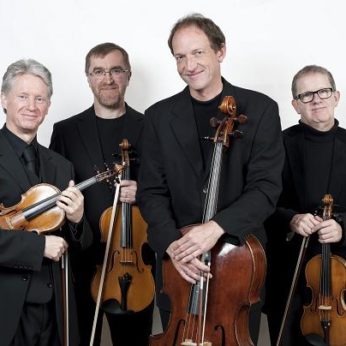Composer: Claude Debussy (b. 1862 - d. 1918)
Performance date: 27/06/2014
Venue: Bantry Library
Composition Year: 1893
Duration: 00:25:47
Recording Engineer: Richard McCullough, RTE
Instrumentation: 2vn, va, vc
Instrumentation Category:String Quartet
Artists:
Vanbrugh Quartet (Gregory Ellis, Keith Pascoe [violins] Simon Aspell [viola] Christopher Marwood [cello]) -
[quartet]

The bell has now tolled to mark my thirty-first year,
and I’m still not confident that my musical attitudes are right; and there are
things I can’t yet do (write masterpieces, for example, or, among other things,
be completely serious – I’m too prone to dream my life away and to see
realities only at the very moment they become insuperable). This letter to his friend and fellow-composer, Ernest
Chausson, dates from the late summer of 1893, just after the completion of his
only string quartet, which posterity would indeed rate as a masterpiece, but
his contemporaries were far from convinced. Debussy’s big breakthrough did not
come for another ten years when the popular success of Pelléas et Mélisande catapulted him to fame.
The string quartet
has a long tradition in
dating from the second half of the eighteenth century, but the Golden Age of
the quartet in
only began with Franck’s quartet of 1890. This inspired similar attempts from
the younger generation of French composers beginning with Vincent d’Indy and
Debussy. They were both pupils of the mystical
old angel, Franck, but Debussy managed to elude much of his post-Romantic
influence, eschewing his predilection for chromaticism. Nonetheless Debussy is
clearly inspired by the complex thematic interplay and the rich cyclical form
of the Franckist school.
The first movement’s
gutsy opening theme returns in many different guises throughout this movement
and indeed throughout the whole work, since it appears in every movement bar the
Andantino. This movement is all action, rhythm and motion – Animé et très décidé. The second
movement uses pizzicato to an extent never before imagined. The motto from the
first movement, now transformed into 6/8 time, continues almost throughout. The
effect is electrifying, something like an updated version of Mendelssohn’s
Walpurgisnacht in the Scherzo of the Octet.
The trio shimmers and glitters before the pizzicatos come dancing back.
The transcendental
Andantino is the spiritual centre of the work, an oasis of calm amid the
virtuosity of the other movements. Muted
for the most part, its veiled beauty lingers in the mind long after more
obviously insistent music. The last
movement seems reluctant to break the spell, but, eventually a headlong accelerando
leads back to the first movement’s motto theme and the return of reality.
Reality is tempered by a moment of peacefulness recalling the Andantino, but
the music gathers momentum again for a forceful conclusion.
Copyright © 2024 West Cork Music. All rights reserved.
Designed and developed by Matrix Internet